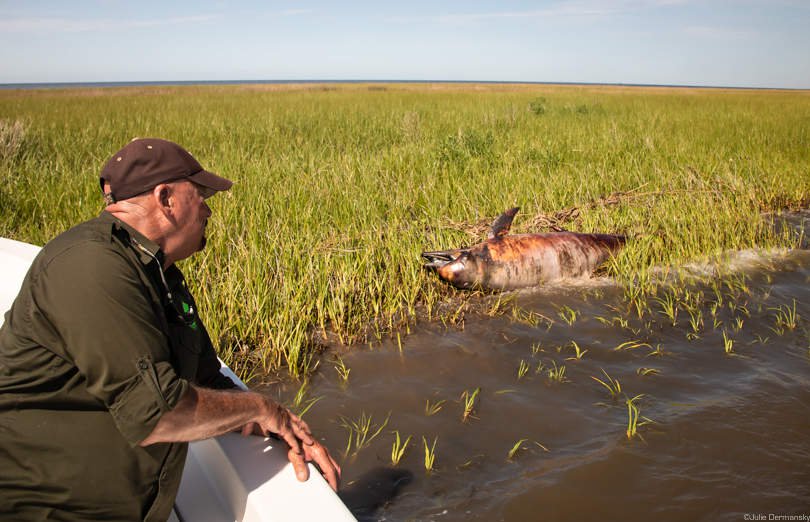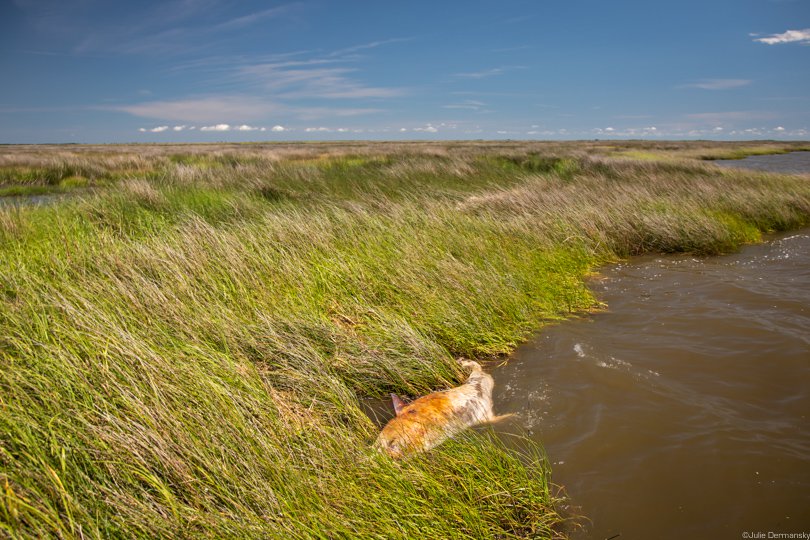
As an unprecedented amount of floodwater makes its way down the Mississippi River, the U.S. Army Corps of Engineers opened the Bonnet Carre Spillway for the second time this year. Done to prevent New Orleans from being flooded, the action marks the first time the spillway, which diverts the Mississippi’s nutrient- and pollutant-heavy freshwater into Lake Pontchatrain, has been opened twice in the same year.
The historic opening of the spillway is happening in the midst of an ongoing and mysterious dolphin die-off in the Gulf of Mexico and the same week that the United Nations released its most comprehensive report on the state of biodiversity.
The report warns that the rate species are going extinct is speeding up and can only be slowed by simultaneously combating climate change and directly protecting species and their habitats. But in Louisiana, despite more frequent and intense extreme weather and the current dolphin die-off, the local, state, and federal governments are showing little political appetite to deal with either.
Only last week, the Corps announced it would open the spillway again this year, but quickly moved up the planned date of May 14 to May 10 after regional rainfall caused the Mississippi River to rise 6 inches in 24 hours, with more rain expected this weekend.


The diverted freshwater will make its way from Lake Pontchartrain to the Breton and Mississippi Sounds, where a dolphin die-off is underway. The Breton Sound, a fish- and oyster-rich estuary where salt and freshwater meet, is located about 35 miles southeast of New Orleans and leads into the Gulf of Mexico. Historically, freshwater from the Mississippi River fed the sounds, but devices like locks and dams have drastically reduced the water flow into them over the years, creating more brackish environments than normal. These water-control mechanisms, created to protect human developments along the Mississippi River, allow for controlled releases such as the one today.
A Meeting Postponed
This morning, May 10, inclement weather postponed a meeting scheduled for the National Oceanic and Atmospheric Administration (NOAA), the lead agency investigating the dolphin deaths to meet with the Louisiana Department of Wildlife and Fisheries (LDWF); the Army Corps of Engineers; the National Audubon Society; and local officials and fishermen in St. Bernard Parish to discuss how to respond to the dolphin die-off.

“Everything is weather-related in Louisiana,” said Randy Myers of LDWF when he alerted me of the postponed meeting. His comment comes off as particularly poignant in a state where climate science deniers continue to govern as if humankind’s role in climate change were insignificant.
On May 1, Gov. John Bel Edwards tripled-down on climate denial at the Grow Louisiana Coalition “Oil and Natural Gas Industry Day” in Baton Rouge. Edwards acknowledges that the climate is changing but diverges from mainstream climate science by saying he is unsure what humanity’s role is. His stance is echoed by his administration’s efforts to welcome new oil and gas industry projects in the state, including numerous petrochemical plants.
“This Is Not Normal”

George Ricks, a fishing charter boat captain, and founder of The Save Louisiana Coalition, was disappointed that the meeting with NOAA was canceled. He and other fishermen in St. Bernard Parish have taken to monitoring the recent dolphin die-off on their own. I accompanied him on a monitoring trip on May 7. We found three dead dolphins in three hours.
“This is not normal,” Ricks said, visibly upset when our boat approached each dolphin. In the 52 years he has been out on the water in this area, he had only come across two dead dolphins, and those were likely killed by boat strikes, he told me. This year he started spotting dead dolphins on April 10. Two were found within two miles of each other. Since then, he has documented 36 dead dolphins, including the three we found that day.

Ricks cringes when he hears people talk about how natural it is for freshwater from the river to come into the estuary. “If the Mississippi River was a babbling brook, we would be OK,” he says, “but we are talking about the second-most polluted river in the United States, loaded with benzene, mercury, phosphates, nitrates, all the fertilizer from farming practices — the same river causing the dead zone in the gulf every year, but that is what we have emptying into our estuaries, and this is the result of it. These animals just can’t take it.”
For oystermen, the opening of the spillway is always a cause for concern because it leads to plummeting water salinity levels as the freshwater suddenly dilutes the estuary’s brackish waters, which can kill the oysters they harvest.
Watching for Impacts
Today, an LDWF press release said the agency is continuing to monitor the area’s fish and wildlife, an effort began with the first spillway’s opening on Febuary 25. It is monitoring Louisiana’s oyster, shrimp, and crab populations, as well as impacts to federally managed marine mammals and sea turtles.
“It is likely some oyster beds will see an impact, especially if salinities remain low and water temperatures rise,” said Patrick Banks, LDWF Assistant Secretary for Fisheries, “but we are confident that the areas will be able to rebound just as Mother Nature intended.”
St. Bernard Parish President Guy McInnis declared a state of emergency today due to the second spillway opening because it will impact hundreds of his parish’s residents who depend on the local seafood industry.
The parish government wrote in a statement on its social media page that preliminary feedback from the LDWF suggesets the dolphins might be suffering from freshwater lesions due to the Bonnet Carre Spillway’s openings, but the science isn’t conclusive on the die-off’s cause.
Ricks doesn’t think enough is being done to uncover the cause of the dolphins’ demise. He wonders if politics are preventing an aggressive investigation into the die-off and believes that if the public became aware that the river’s water is implicated in killing dolphins, then public opinion might turn against the diversion projects, which are key to the state’s Coastal Master Plan to rebuild and protect Louisiana’s diminished coast.

These projects, the proposed Mid-Barataria and Mid-Breton sediment diversions, are part of the state’s plan to reduce coastal land loss. While the projects have wide support, they required a waiver from the Marine Mammal Protection Act, to all construction without further study of whether they will harm marine mammals, including dolphins.
I asked the Louisiana Department of Wildlife and Fisheries when it last monitored the dolphin die-off situation. Myers told me the agency is activity monitoring but couldn’t tell me the specifically the last time the agency checked in the Breton Sound. With more Mississippi River water headed that way, Ricks plans to keep a watchful eye on the area, with or without the help of government agencies.
A Glimpse of the Future?
Criticism of the two proposed diversion projects comes mostly from oystermen and charter boat operators but the projects’ supporters readily dismiss the criticism, saying the state has to do something to protect and rebuild the disappearing coast. Louisiana has been losing coastal land for decades due to damage done by the oil and gas industry, extreme weather events and sea level rise worsened by climate change and subsidence, among other causes.
Ricks insists he isn’t just opposing the sediment diversions because the projects will impact his business. He also points to the U.S. Army Corp of Engineers report, released in March, on managing the Lower Mississippi River Delta. According to this report, “the morphologic modeling results for the diversion scenario analyses show net land gain in the near vicinity of the diversion outlets and net land loss farther away from the outlets.” In other words, these types of projects would likely build the same amount of land in one area that they erode elsewhere.
Ricks sees the report as a vindication of his belief that the sediment diversion projects could end up destroying as much land as they create.
Warnings Coming True
In March, NOAA forecasters noted the high risk of “major flooding due to well-above-normal precipitation, snowmelt, saturated soils, and frozen ground” in areas feeding the Mississippi River this spring.
And this week, NOAA reported that 313 river gauges across the United States showed levels above flood stage. All but five of those gauges were in the U.S. heartland, mostly within the Mississippi River watershed.
Just last year federal scientists warned that impacts to the Gulf of Mexico region, such as worsening floods, heat waves, and sea level rise, will intensify as the globe continues warming.
While a global chorus of scientists say there is still time to avoid the worst impacts of climate change, that time is quickly running out.
Join us in defending the truth before it’s too late
The future of independent journalism is uncertain, and the consequences of losing it are too grave to ignore. We have hours left to raise the $12,0000 still needed to ensure Truthout remains safe, strong, and free. Every dollar raised goes directly toward the costs of producing news you can trust.
Please give what you can — because by supporting us with a tax-deductible donation, you’re not just preserving a source of news, you’re helping to safeguard what’s left of our democracy.